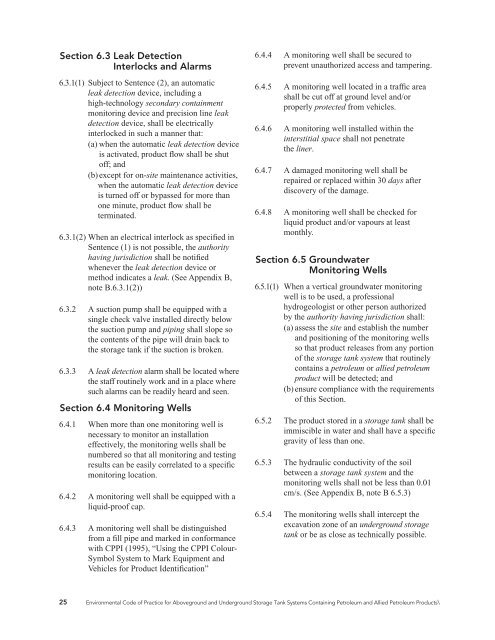Environmental Code of Practice for Aboveground and ... - CCME
Environmental Code of Practice for Aboveground and ... - CCME
Environmental Code of Practice for Aboveground and ... - CCME
Create successful ePaper yourself
Turn your PDF publications into a flip-book with our unique Google optimized e-Paper software.
Section 6.3 Leak Detection<br />
Interlocks <strong>and</strong> Alarms<br />
6.3.1(1) Subject to Sentence (2), an automatic<br />
leak detection device, including a<br />
high-technology secondary containment<br />
monitoring device <strong>and</strong> precision line leak<br />
detection device, shall be electrically<br />
interlocked in such a manner that:<br />
(a) when the automatic leak detection device<br />
is activated, product flow shall be shut<br />
<strong>of</strong>f; <strong>and</strong><br />
(b) except <strong>for</strong> on-site maintenance activities,<br />
when the automatic leak detection device<br />
is turned <strong>of</strong>f or bypassed <strong>for</strong> more than<br />
one minute, product flow shall be<br />
terminated.<br />
6.3.1(2) When an electrical interlock as specified in<br />
Sentence (1) is not possible, the authority<br />
having jurisdiction shall be notified<br />
whenever the leak detection device or<br />
method indicates a leak. (See Appendix B,<br />
note B.6.3.1(2))<br />
6.3.2 A suction pump shall be equipped with a<br />
single check valve installed directly below<br />
the suction pump <strong>and</strong> piping shall slope so<br />
the contents <strong>of</strong> the pipe will drain back to<br />
the storage tank if the suction is broken.<br />
6.3.3 A leak detection alarm shall be located where<br />
the staff routinely work <strong>and</strong> in a place where<br />
such alarms can be readily heard <strong>and</strong> seen.<br />
Section 6.4 Monitoring Wells<br />
6.4.1 When more than one monitoring well is<br />
necessary to monitor an installation<br />
effectively, the monitoring wells shall be<br />
numbered so that all monitoring <strong>and</strong> testing<br />
results can be easily correlated to a specific<br />
monitoring location.<br />
6.4.2 A monitoring well shall be equipped with a<br />
liquid-pro<strong>of</strong> cap.<br />
6.4.3 A monitoring well shall be distinguished<br />
from a fill pipe <strong>and</strong> marked in con<strong>for</strong>mance<br />
with CPPI (1995), “Using the CPPI Colour-<br />
Symbol System to Mark Equipment <strong>and</strong><br />
Vehicles <strong>for</strong> Product Identification”<br />
6.4.4 A monitoring well shall be secured to<br />
prevent unauthorized access <strong>and</strong> tampering.<br />
6.4.5 A monitoring well located in a traffic area<br />
shall be cut <strong>of</strong>f at ground level <strong>and</strong>/or<br />
properly protected from vehicles.<br />
6.4.6 A monitoring well installed within the<br />
interstitial space shall not penetrate<br />
the liner.<br />
6.4.7 A damaged monitoring well shall be<br />
repaired or replaced within 30 days after<br />
discovery <strong>of</strong> the damage.<br />
6.4.8 A monitoring well shall be checked <strong>for</strong><br />
liquid product <strong>and</strong>/or vapours at least<br />
monthly.<br />
Section 6.5 Groundwater<br />
Monitoring Wells<br />
6.5.1(1) When a vertical groundwater monitoring<br />
well is to be used, a pr<strong>of</strong>essional<br />
hydrogeologist or other person authorized<br />
by the authority having jurisdiction shall:<br />
(a) assess the site <strong>and</strong> establish the number<br />
<strong>and</strong> positioning <strong>of</strong> the monitoring wells<br />
so that product releases from any portion<br />
<strong>of</strong> the storage tank system that routinely<br />
contains a petroleum or allied petroleum<br />
product will be detected; <strong>and</strong><br />
(b) ensure compliance with the requirements<br />
<strong>of</strong> this Section.<br />
6.5.2 The product stored in a storage tank shall be<br />
immiscible in water <strong>and</strong> shall have a specific<br />
gravity <strong>of</strong> less than one.<br />
6.5.3 The hydraulic conductivity <strong>of</strong> the soil<br />
between a storage tank system <strong>and</strong> the<br />
monitoring wells shall not be less than 0.01<br />
cm/s. (See Appendix B, note B 6.5.3)<br />
6.5.4 The monitoring wells shall intercept the<br />
excavation zone <strong>of</strong> an underground storage<br />
tank or be as close as technically possible.<br />
25 <strong>Environmental</strong> <strong>Code</strong> <strong>of</strong> <strong>Practice</strong> <strong>for</strong> <strong>Aboveground</strong> <strong>and</strong> Underground Storage Tank Systems Containing Petroleum <strong>and</strong> Allied Petroleum Products\

















